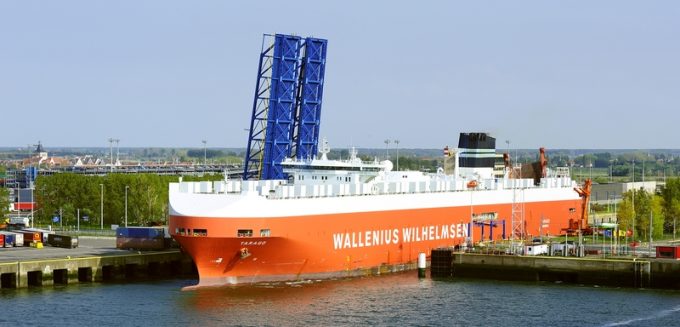EU tariffs on Chinese EV imports not expected to put the brake on sales
The EU imposition of tariffs on Chinese electric vehicles this month is not expected to ...
TFII: SOLID AS USUALMAERSK: WEAKENINGF: FALLING OFF A CLIFFAAPL: 'BOTTLENECK IN MAINLAND CHINA'AAPL: CHINA TRENDSDHL: GROWTH CAPEXR: ANOTHER SOLID DELIVERYMFT: HERE COMES THE FALLDSV: LOOK AT SCHENKER PERFORMANCEUPS: A WAVE OF DOWNGRADES DSV: BARGAIN BINKNX: EARNINGS OUTODFL: RISING AND FALLING AND THEN RISING
TFII: SOLID AS USUALMAERSK: WEAKENINGF: FALLING OFF A CLIFFAAPL: 'BOTTLENECK IN MAINLAND CHINA'AAPL: CHINA TRENDSDHL: GROWTH CAPEXR: ANOTHER SOLID DELIVERYMFT: HERE COMES THE FALLDSV: LOOK AT SCHENKER PERFORMANCEUPS: A WAVE OF DOWNGRADES DSV: BARGAIN BINKNX: EARNINGS OUTODFL: RISING AND FALLING AND THEN RISING

In the face of declining demand for cars in mature markets, shipping lines specialising in shipping them are ordering virtually no new vessels and are increasingly looking at port investments to improve profitability.
According to new analysis from Drewry Maritime Advisers, some 22.8 million finished vehicles were carried on the oceans last year, a growth of 1%, and its new report, Finished Vehicles Annual Review and Forecast 2019/20, says the trade will likely see similar growth this year.
And this is despite a decline in car sales in Europe, North America and China, now the world’s largest car market.
However, it also sas there has been much higher growth on secondary trades.
“North-south and intra-regional trades continue to gain market share, compared with hitherto dominant east-west routes, offering opportunities for triangulation,” said Tom Ossieur, head of car carriers at Drewry.
“However, matching supply and demand is becoming increasingly challenging for car carriers in the current climate of rising trade tensions and low forward traffic visibility,” he added.
Despite the slack volume growth, the report adds that many of the largest dedicated finished vehicle terminals in Europe and North America are approaching capacity, and terminal operators – which often operate in combination with carriers – have embarked on expansion projects which are likely to generate “strong financial returns”.
It adds: “Similarly, ports in developing regions remain in need of new investment and finished vehicle handling expertise to accommodate rising auto traffic, particularly as carrier deployment of larger vessels is compromising operational efficiency at these ports.”
However, Mr Ossieur added that the need for investment in ports on secondary trades could trigger a new wave of consolidation activity in the sector.
“Unlike car carrier shipping, the global vehicle port terminal sector is highly fragmented, with the need for investment likely to trigger more consolidation.
“Poor financial returns from carrier liner operations and an uncertain trade outlook will force a rise in distressed vessel sales and a diversion of investment to more profitable port assets,” he said.
Comment on this article